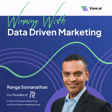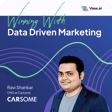
How Fave uses data to skyrocket marketing ROI by segmenting and targeting the right customers
Hosted by Julie from Vase.ai Market Research. In this episode, we speak with Chen Chow, the co-founder of Fave, one of the leading cashback apps in Southeast Asia. You will learn Chen Chow's perspective on :
Using data to create and improve products for different segments and markets, such as the Jobstreet English Language Assessment (JELA) and the Fave;
Leveraging data to grow Fave’s user base, revenue and retention, and how they optimized the marketing channels, such as email and push notifications
Approaching data-driven marketing in Southeast Asia, and what are the challenges and opportunities in this diverse and dynamic region.
In today’s episode, we discuss :
00:00 Introduction
01:23 Chen Chow's career & background
04:37 The importance of having clear positioning for your product & business
09:31 How to choose the right target segment for your product
13:47 Use a balance of data and intuition to choose the right target segment
19:28 Designing cashback the right way as part of retention strategy
32:23 Monitor your inputs and outputs as key metrics
46:02 Lighting round - Advice for those interested to pursue a career in marketing
This episode is full of insights and stories from a leader who has been at the forefront of marketing, technology and data in Southeast Asia.







